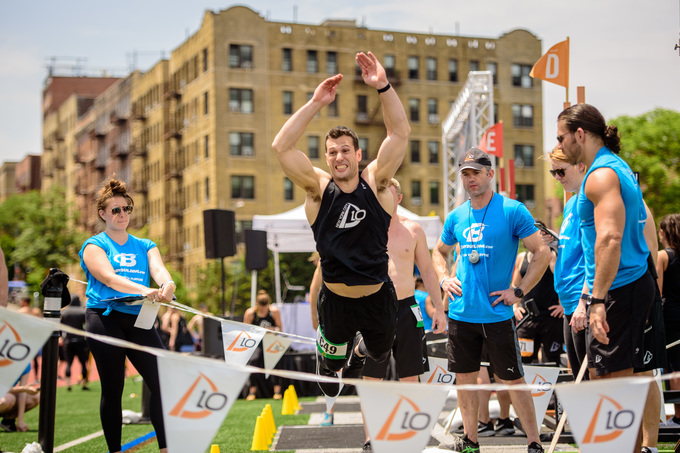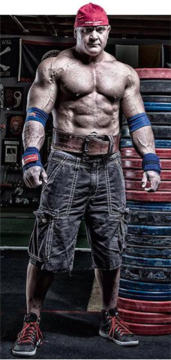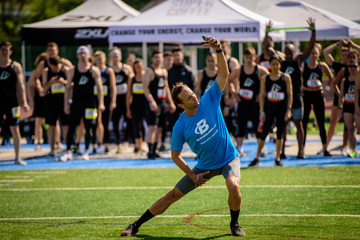Train With Purpose: Better Squats for a Better Beach Butt
July 9, 2018
 Train With Purpose is a series brought to you in partnership with bodybuilding.com.
Train With Purpose is a series brought to you in partnership with bodybuilding.com. by Mark Bell
Bodybuilding.com contributor Mark Bell, aka "Smelly" from the documentary feature Bigger, Stronger, Faster, is a champion powerlifter. This post has been slightly adapted from its original form.
We all know how it goes in the squat rack: the weight gets heavier, and your form gets worse. I see this all the time: At heavier weights, the hips don't lower, and the torso bows forward. Heavy squats can also come with caving knees, over-extended necks, and arched spines. Some of you might have multiple dysfunctions like this, and you might not see them until you start throwing more plates on the bar.
Doing squats well isn't an easy thing, especially if you're going heavy. They're made worse by bad cues from crap coaches and trainers. Here's the truth about squats and what you can do to improve your number.
SQUATS 101
Before we get going, there are a couple things you need to keep in mind. For those of you non-powerlifters, a squat is only legal if your hips go below your knees. That's called breaking parallel. We're trying to lower the hips through the entire lowering portion of the lift. It's also important to know that we're trying not to allow the knee to follow too far downward. They can go forward, but not downward.Think of a sissy squat: your kneecaps can go way down but your hips never get below where your knees are. So, think about hinging those hips first, not bending your knees. I want you to know that bowing forward in a squat is acceptable—and in some cases, preferred. Powerlifters like me put the bar lower on their back, so leaning forward is natural. However—and this is a big however—if you do lean forward, don't let your chin get too far away from your chest.
MINIMIZING DYSFUNCTION
If you bow forward with your head too high and your chin too far away from your chest, you get this weird arched-back, stripper thing going on. That's no good. Things will just get crazy if you do that. What usually happens is your butt will shoot up first. If you're already leaning forward in a squat and your butt shoots up first, you're asking for trouble. Now you're turning this lift into a two-part "good morning" lift. It hurts my lower back just thinking about it.To avoid the good-morning squat, make sure your eyes are looking downward. I've even had some people look at their shoes. I know it sounds weird. You don't have to look at your shoes, but look down and forward; I want you to maintain a neutral spine. Neutral spines are strong. Some people are straight-up quad lifters and are super-upright when they squat. Although I'm not saying that's the best way to lift, if you like squatting that way, make sure your knees aren't coming together on the way up. If they cave in when you lift heavy, you're going to miss the lift. Keep your knees out.

BETTER SQUATS
We've been over some coaching cues for better squats. Good form can go a long way, but there are other things you can do to feel stronger when you have heavy weight on your back.MOBILIZE
Before you begin squatting, spend at least 10 minutes warming up and mobilizing your hips. If you're in a commercial gym, hop on a bike or elliptical. It’s summertime now in the U.S., but warming up is especially important in the winter when it's really, really cold. Wear some extra layers. Get that body temp up. Get your body moving properly, because when you're cold it's really hard to get your body to perform optimally. Jump rope, do jumping jacks, pull a sled—anything. Next, do some stretching and mobilizing. I recommend doing warm-ups from Kelly Starrett, a coach who is also a doctor of physical therapy. You have to mobilize your hips. Get them to open up. Move better and have a better squat session. Sit at the bottom of that squat and move around in it. Move your hips forward, back, side to side. Do good mornings unweighted or with light weight. Work out the kinks. Take whatever weight and do a set of 10, take a few extra sets in your warm-up progressions and get yourself ready. Preparing your body to do the work will do a lot for your squat. It's definitely a lot harder to do good squats if your muscles are tight and cold.

DO SQUAT VARIATIONS
After your heavy training sets, or even instead of your heavy sessions, try doing squat variations. Do pause squats, front squats, hack squats, leg presses, or single-leg squats and lunges. These variations will help strengthen your legs so you don't have to rely on your back to do the work.Maybe your best squat is 315. There's nothing wrong with doing 225 for 10 sets of 3. Work at being precise; push against your best. Do sets of 5, 8, or 10 reps and try to stay upright throughout every rep. The goal is to become a proficient squatter, not just a strong one. We're in the gym to get better, to move the weight better.
STRENGTHEN YOUR ABS
A belt can be a great addition to your gym bag, but you can't rely on it. Despite what Bro Shmo tells you, your belt doesn't really brace your back, but rather gives your stomach something to brace against. Don't suck your belly button in. Some experts say "suck the stomach in," or "pull the belly in." Those are a bunch of suckers. I've squatted more than 1,000 pounds many times in competition and have been around some guys who are much stronger than me. Trust me: You need to push outward against that belt. Ab exercises will actually improve your stability and help you keep upright. Emphasize pushing outward with your belly. Try doing ab exercises with a belt on. I'm a big fan of weighted sit-ups. Sure, your legs are the main players in a squat, but without strong abdominals, you're never going to have the strength or stability to do them with good form.
Are you ready to start moving the weight better? How about tutorials on all of the above techniques, plus many others, and personal coaching from an Olympic and World Champion athlete? Gold Medalist Adam Nelson's D10-specific training program is now available.
Get it here.